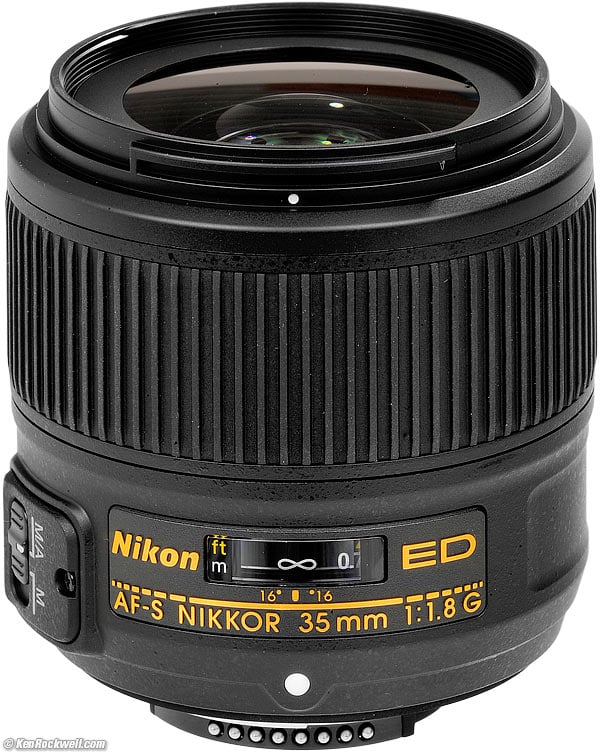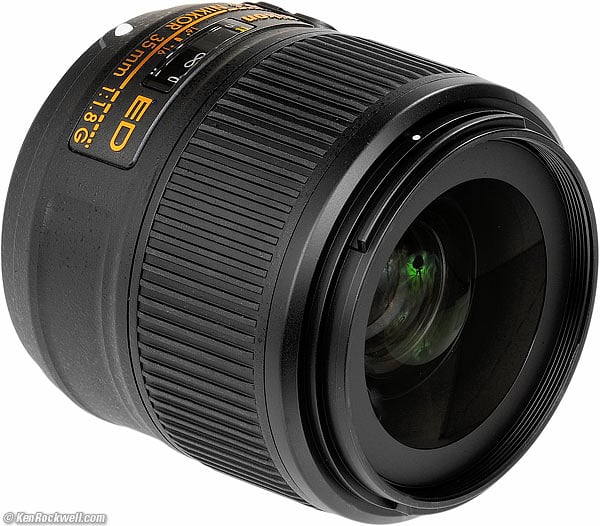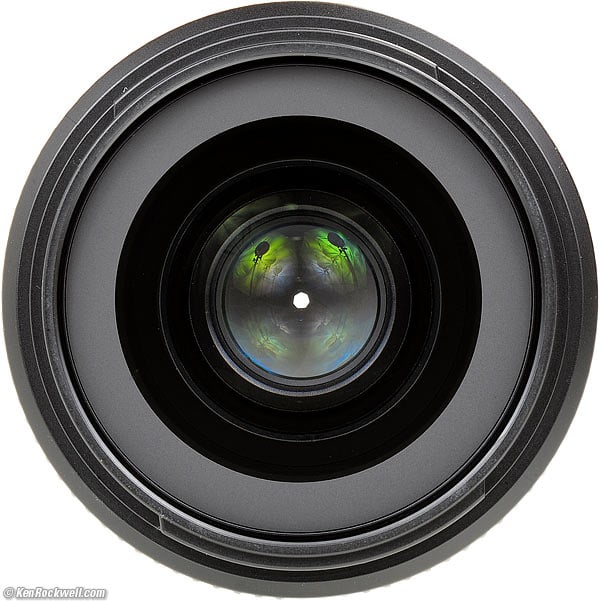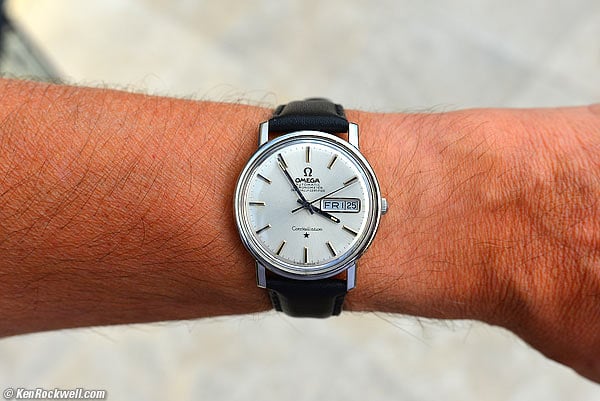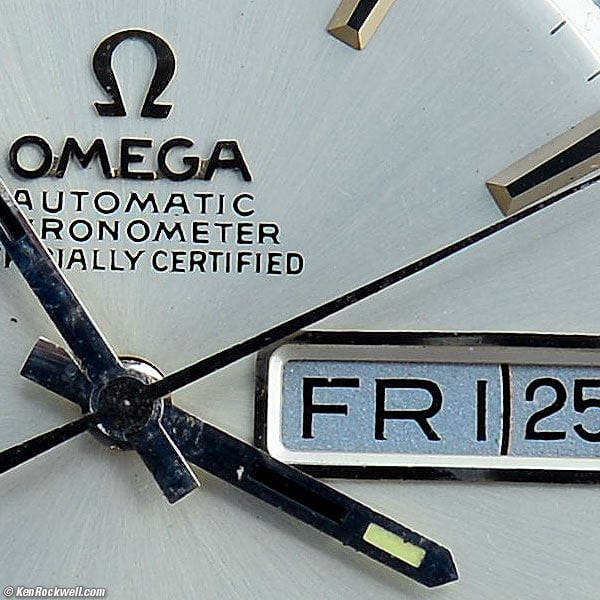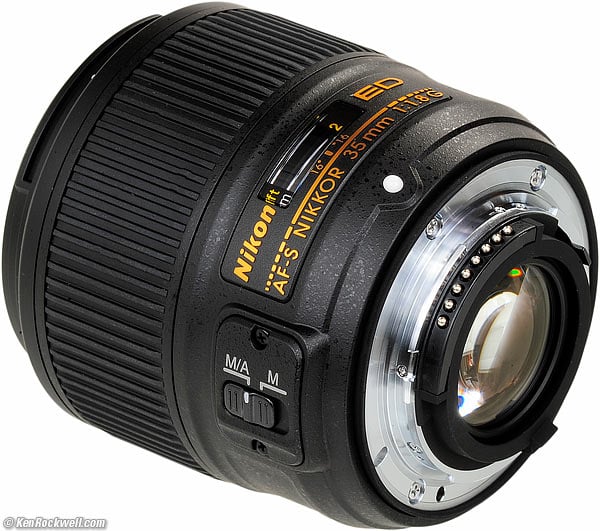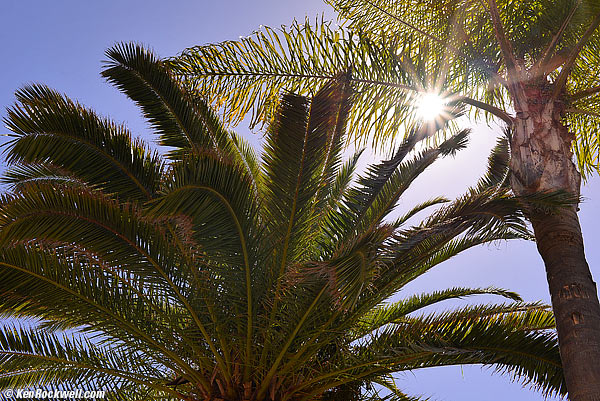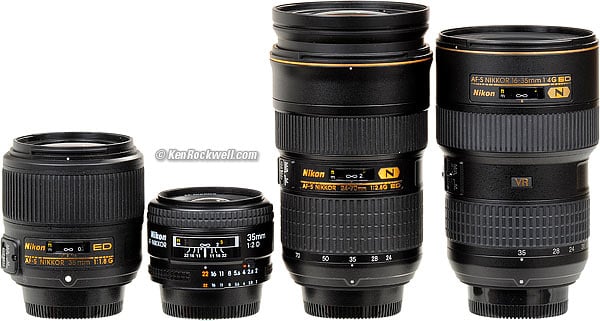Home Donate New Search Gallery Reviews How-To Books Links Workshops About Contact
Nikon 35mm f/1.8 FX
AF-S G NIKKOR (2014-)
Intro Specs Performance Compared Usage Recommendations
Nikon 35mm f/1.8 G FX AF-S (FX, DX and 35mm coverage, 58mm filters, 10.7 oz./304g, 0.85'/0.25m close focus, 0.24× macro ratio, $527 or about $275 used). enlarge.
I got mine at Adorama. I'd also get it at B&H or at Crutchfield, or used at eBay if you know How to Win at eBay.
This 100% all-content, junk-free website's biggest source of support is when you use those or any of these links to my personally approved sources I've used myself for way over 100 combined years when you get anything, regardless of the country in which you live — but I receive nothing for my efforts if you take the chance of getting it elsewhere. Nikon does not seal its boxes in any way, so never buy at retail or any other source not on my personally approved list since you'll have no way of knowing if you're missing accessories, getting a defective, damaged, returned, dropped, incomplete, gray-market, store demo or used lens — and my personally approved sources allow for 100% cash-back returns for at least 30 days if you don't love your new lens. I've used many of these sources since the 1970s because I can try it in my own hands and return it if I don't love it, and because they ship from secure remote warehouses where no one gets to touch your new lens before you do. Buy only from the approved sources I've used myself for decades for the best prices, service, return policies and selection.
August 2023, July 2014 Nikon Reviews Nikon Lens Reviews All Reviews
Why Fixed Lenses Take Better Pictures
Ideal for: Perfect for use on FX digital and 35mm autofocus cameras.
Not for: Don't use this FX lens on a DX camera. Use the 35mm f/1.8 DX lens instead for a fraction of the price. Likewise, this G lens won't work on older 35mm AF or manual-focus cameras; use the 35mm f/2 AF or 35mm f/2 AI-s instead.
See also
Nikon 35mm f/1.8 DX for DX digital cameras
35mm f/2 AF-D Nikon's classic version of this new lens.
Nikon 3.5cm f/1.8 the world's first 35mm f/1.8 lens, for Nikon's 35mm rangefinder cameras only.
Introduction top
Intro Specs Performance Compared Usage Recommendations
This Nikon 35mm f/1.8G lens is a compact, lightweight, fast normal to wide-angle lens for full-frame FX and 35mm cameras. It has great optics and ergonomics in a lightweight housing. Grab the focus ring at any time for instant manual-focus override.
It works great on DX cameras, but you're paying a lot more than you need to, since for DX, the 35mm f/1.8 DX does exactly the same thing for one-third the price.
The reasons to get this 35mm lens are if you are traveling light or prefer a small, fast, fixed wide lens over a slower, larger zoom.
This 35mm prime (fixed) lens is also much sharper than the $1,900 24-70mm f/2.8 AF-S G zoom at large apertures in the corners, as well as much faster so you won't need to use as high an ISO in dim light.
Optically, this 35mm f/1.8 is superb, but not that much better than any of Nikon's other 35mm lenses or zooms in actual shooting. The reason get this 35mm is speed for shooting action in low-light (or for shooting slow 35mm film in iffy light), or if you need instant manual-focus override simply by grabbing the big focus ring. Otherwise, this new lens isn't much different in performance compared to Nikon's existing 35mm f/2 AF-D which is even smaller, lighter and less expensive.
As an FX lens, this review is written for use on FX. On DX, no big deal; just know that when I mention the "corners," I'm talking about a part of this lens' image that isn't seen or used on DX. More at Crop Factor.
To use this on mirrorless, use the FTZ or FTZ II adapter, on which it works great — or just get the Z 35mm f/1.8 instead.
Everything works perfectly on every Nikon DSLR, both FX and DX, from the best D4s, D800 and D800E to Nikon's cheapest digitals like the D40, D40x, D60, D3000, D3100, D5000 and D5100.
It's also perfect on decent or recent AF film cameras like the F6, F100, F5, N80 and N75.
The incompatibilities for older or cheaper 35mm cameras are that:
1.) It won't autofocus with the cheapest new AF 35mm cameras like the N55, but if you focus manually, everything else works great. Even if you lose autofocus, these cameras have in-finder focus confirmation dots to help you.
2.) Late 1980s ~ early 1990s AF cameras like the N90s, N70 and F4 will focus just fine. You'll have Program and Shutter-priority modes, but will lose Manual and Aperture-priority since you have no way to set the aperture on the camera or on the lens.
3.) You're really pushing it with the oldest AF cameras like the N2020, N6006 and N8008. You'll have no AF and confused exposure modes. Manual focus is fine, along with electronic focus indications.
4.) Since it has no aperture ring, it's just about useless with manual focus film cameras. It will shoot every shot at its minimum aperture, and probably meter incorrectly.
See Nikon Lens Compatibility for details with your camera. Read down the "AF-S, AF-I" and "G" columns for this lens. You'll get the least of all the features displayed in all columns, since "G" (gelding) is a deliberate handicap which removes features.
Nikon 35mm f/1.8G FX. bigger.
Specifications top
Intro Specs Performance Compared Usage Recommendations More
Name top
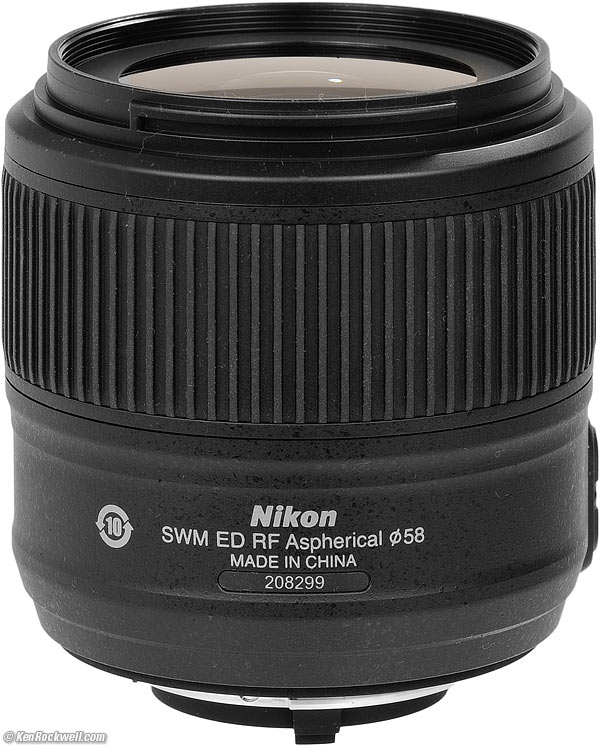
Bottom view.
Nikon calls this the Nikon AF-S NIKKOR 35mm f/1.8G.
NIKKOR: Nikon's brand name for all their lenses.
AF-S and SWM: Silent Wave Autofocus Motor.
ED: Magic Extra-low Dispersion glass for reduced secondary chromatic aberration.
RF: Rear focusing; nothing moves externally as focused except the rear element.
Aspherical: Specially curved glass to give even sharper pictures.
∅58: 58mm filter thread.
G: Gelded for cost-reduction and removing compatibility with older cameras.
Also includes:
D: Couples distance information to the Matrix Meter. All Gelded lenses are also D.
Optics top

Nikon 35mm f/1.8 FX diagram. ED and Aspherical elements.
11 elements in 9 groups.
One ED element and one aspheric element.
Rear focus.
It's multicoated, called "Super Integrated Coating" (SIC) by Nikon.
Diaphragm top
Nikon 35mm f/1.8G FX at f/16. bigger.
7 rounded blades.
Stops down to f/16.
Relatively round to f/2.8, and relatively heptagonal from f/5.6.
Coverage top
Focal Length top
35mm.
When used on a DX camera, it gives angles of view similar to what a 50mm lens gives when used on an FX or 35mm camera.
Angle of View top
63° on FX digital and 35mm.
52º on Pronea APS.
44° on small-format DX.
Close Focus top
0.85 feet (9.8" or 0.25 meters) from the image plane (back of camera), which is much closer to the front of the lens.
Maximum Reproduction Ratio top
1:4.2 (0.24x).
Hard Infinity Focus Stop? top
No.
You have to let the AF system focus at infinity.
Focus Scale top
Yes, abbreviated.
Depth-of-Field Scale top
No, unless you consider the two useless tits only at f/16 as a depth-of-field scale. I don't.
Infra-Red Focus Index top
No.
Aperture Ring top
No.
Filter Thread top
58 mm, plastic.
Does not move.
Size top
Nikon specifies 2.8" (72.0 mm) diameter by 2.8" (71.5 mm) extension from flange.
Weight top
10.710 oz. (303.7g), actual measured.
Nikon specifies 10.8 oz. (305 g).
Hood top
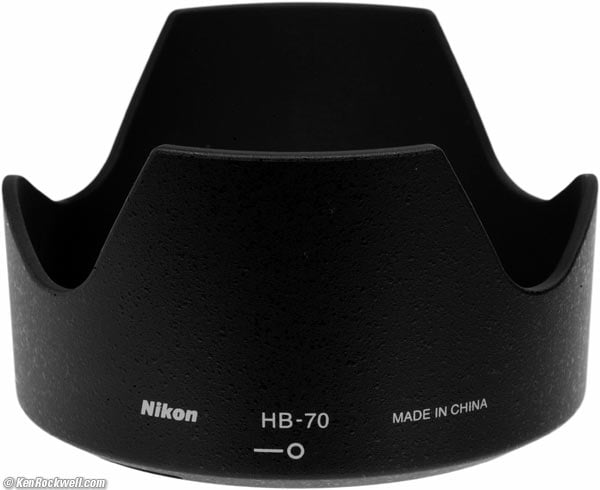
Nikon HB-70 hood.
Plastic bayonet HB-70 hood, included.
Caps top
Excellent LC-58 front cap and new-style dust-covering LF-4 rear cap.
Case top
Fuzzy pouch CL-0915 included, but a tube sock has better cushioning and is easier to use.
Included top
Lens.
LC-58 front cap.
LF-4 rear cap.
HB-70 plastic bayonet hood.
CL-0915 sack.
Instructions and warranty.
Quality top
Lens: Made in China.
LR-4 rear cap: Made in Thailand.
LC-58 front cap: Made in Thailand.
Warranty top
5 years, USA.
Packaging top
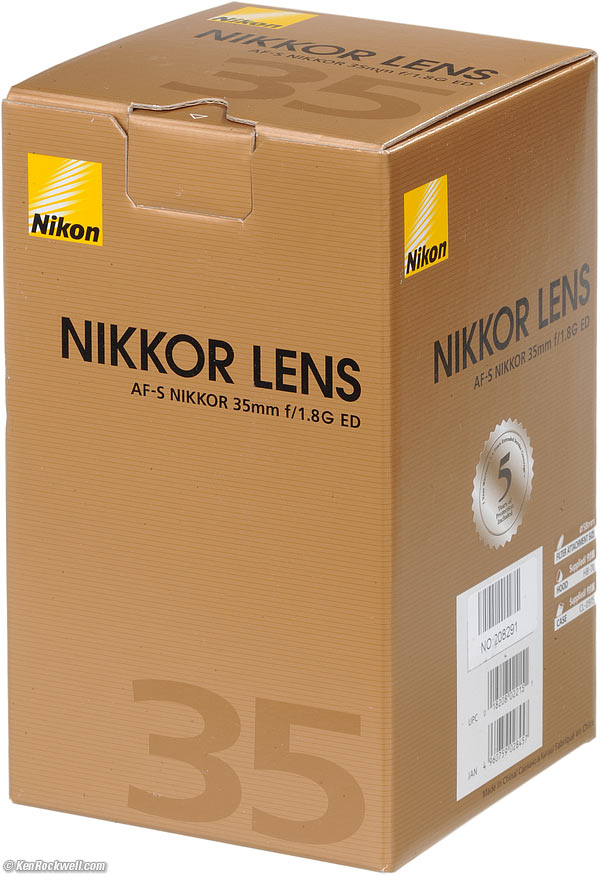
Box, Nikon 35/1.8 FX.
Gold-colored micro-corrugated box with the lens and hood stuck in translucent plastic:
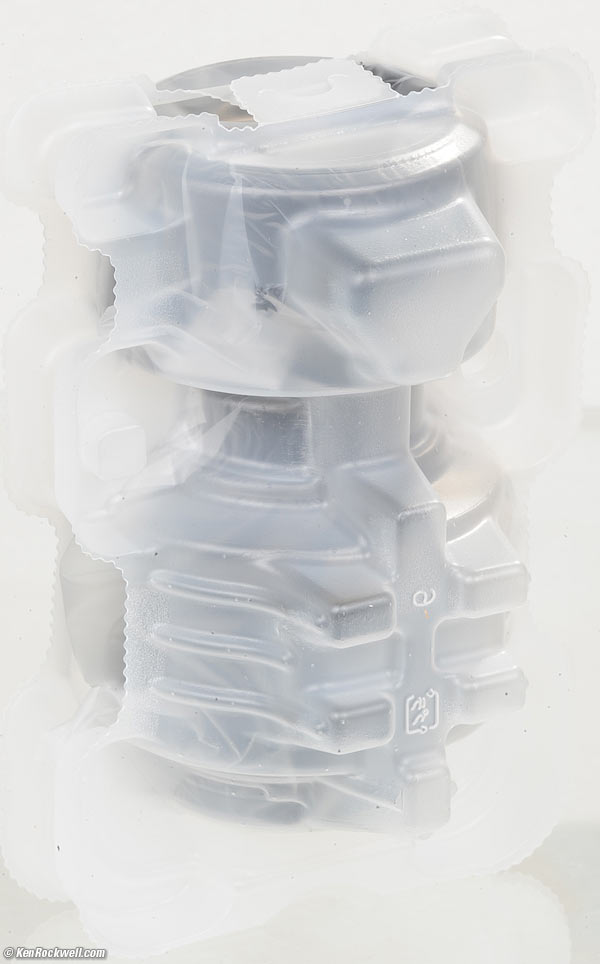
Frozen in Smoke: Nikon 35/1.8 FX inside the box.
Announced top
07 January 2014.
Promised for top
February 2014.
Available Since top
February 2014.
Price, USA top
January 2014 (Introduction)
$600.
Performance top
Intro Specs Performance Compared Usage Recommendations
Overall Autofocus Bokeh Color Coma Distortion
Ergonomics Falloff Filters Focus Breathing Ghosts
Hood Lateral Color Fringes Macro Mechanics
Sharpness Spherochromatism Sunstars Survivability
Overall performance top
The Nikon 35mm f/1.8 G is a fast, sharp, light, fast-focusing wide-angle lens.
It lets in more light than any f/2.8 zoom for shorter shutter speeds or lower ISOs for sharper, clearer pictures in low light.
Autofocus performance top
Overall
AF is fast and accurate.
Just grab the ring at any time for instant manual-focus override.
AF Speed
AF speed is as we'd expect: fast, but not instantaneous.
As with all AF lenses, it won't focus in dimmer light or any faster than slower (f/2.8 or f/4) AF lenses; Nikon's AF system doesn't care about lens speed.
As compared on a D800E, AF is as fast as the 35/2 AF-D.
AF Accuracy
AF is always dead-on.
Manual Focus
Manual focus is a dream.
The manual-focus ring is half of the lens barrel!
Bokeh performance top
Bokeh, the character of out of focus backgrounds, not simply how far out of focus they are, is only fair at f/1.8 and smoother at f/2.8 and smaller.
Color Rendition performance top
The color rendition is the same as my other Nikkor AF lenses.
Coma performance top
Coma (saggital coma flare) often causes weird smeared blobs to appear around bright points of light in the corners of fast or wide lenses at large apertures. In lenses that have it, coma goes away as stopped down.
I can't see any coma in this aspherical lens.
Distortion performance top
The Nikon 35mm f/1.8 G has some barrel distortion, about the same as Nikon's 35mm f/2 manual-focus lens or the 35/2 AF-D. The 35mm f/2.8 AI has less distortion, and Nikon's zooms have a lot more.
This 35/1.8's distortion can be corrected by plugging these figures into Photoshop's lens distortion filter:
∞ |
+2.0 |
10' (3m) |
+1.6* |
* Slight waviness remains.
Used on recent digital cameras like the D90, D3100, D3200, D3300, D5000, D5100, D5200, D5300, D7000, D7100, D4, D4s, D600, D610, D800 and D800E, the distortion can be set to correct automatically in-camera! Be sure the latest firmware is loaded in your camera for it to recognize this new lens.
Ergonomics (handling and ease-of-use) performance top
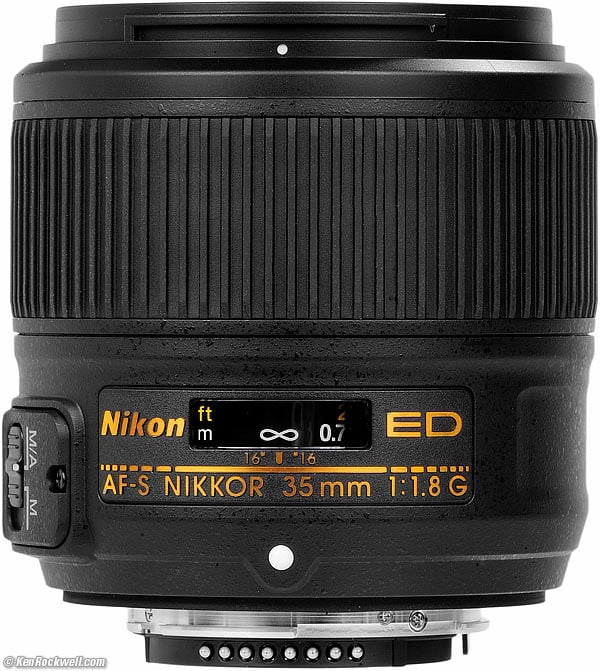
Nikon 35/1.8 FX.
Ergonomics are PERFECT!
This lens is perfectly sized to fit the hand. The only thing to grab is the huge focus ring, which may be grabbed at any time for instant manual-focus override.
If you want to force the lens into manual-focus only, the M/A - M slide switch is positioned perfectly under your thumb.
Falloff (darkened corners) performance top
Falloff on FX and 35mm can be visible at f/1.8 and f/2, and gone by f/2.8. With cameras that offer vignette correction, falloff is only minor even at f/1.8.
Here I've greatly exaggerated the uncorrected falloff by shooting a gray field and presenting it against a gray background.
Nikon 35mm f/1.8 G FX falloff on FX and 35mm at infinity, no correction.
© 2014 KenRockwell.com. All rights reserved.
|
Filters, use with performance top
58mm is a generous filter size.
There is no problem with vignetting, even with three stacked thick filters.
There's no need for "thin" filters.
Feel free to use an adapter to use smaller 52mm filters if you like.
The filter ring never moves.
Focus Breathing performance top
Of interest mostly to cinematographers focusing back and forth between two subjects, the image from the Nikon 35mm f/1.8 AF-S grows larger as focused more closely.
Ghosts performance top
Nikon 35 1.8 FX at f/9. bigger.
There are no ghosts or flare under any reasonable condition.
If you go out of your way to put the brilliant summer sun in your image and put a dark shadow on the other side to look for ghosts, you still won't get anything.
In this shot, I'm staring directly into the summer sun and adding one stop exposure compensation, and then lightening the palm, and still no ghosts.
Hood performance top
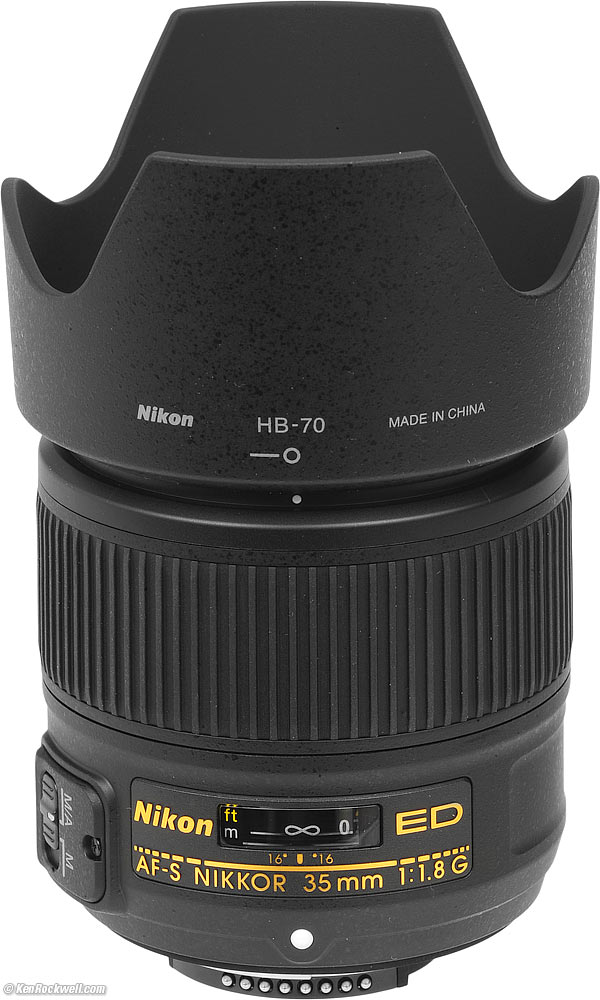
Nikon 35/1.8 FX with HB-70 Hood.
The hood is included.
I leave mine at home; the 35 1.8 has no flare. The only practical reason for the hood is to protect the front of the lens from damage or fingers.
Lateral Color Fringes performance top
There are lateral color fringes in the farthest corners on FX, be it shot on the D600 or D800E, which are supposed to to correct this automatically — and these cameras do correct it with other lenses. No lens profiles are needed for lateral color fringe correction.
The slight yellow-blue color fringes in the FX corners are this lens' one problem. I don't consider it a real problem, but if you're a pixel-splitter who photographs bare trees against gray skies, get the16-35 VR instead, which doesn't have this problem.
There is some spherochromatism, which is an entirely different chromatic aberration.
Macro performance top
Omega Constellation at close-focus distance on full-frame. © 24MP Camera-original file.
Crop from above 24MP image at f/8. If this is 6" (15cm) wide on your screen, then the complete image printed at this same high magnification would be 60 x 40" (150 x 100 cm)! © 24MP Camera-original file.
It doesn't get that close, but it sure is super-sharp.
Mechanics and Construction performance top
Rear, Nikon 35mm f/1.8G FX. bigger.
The Nikon 35mm f/1.8 G AF-S is well made in China mostly out of plastic, with a metal mount.
Filter Threads
Plastic.
Hood
Plastic bayonet.
Hood Mount
Plastic.
Barrel Exterior
Plastic.
Focus Ring
Plastic; rubber covered.
Focus Mechanism
Feels sturdy and precise.
Depth-of-Field Scale
None, except for two foolish little dots for f/16.
Internals
Could be metal or plastic.
Aperture Ring
None.
Mount
Dull-chromed metal.
Markings
Paint.
Mounting Index Dot
White plastic ball.
Identity Plate
Gold-look plastic.
Serial Number
Sticker glued into a recess on the bottom of the lens.
US Model Signified by
"5 Years of Protection Included" sticker on the box, with substantiating Nikon USA paperwork inside the box.
It's not marked on the lens, although the serial number may help. The USA lens here has a serial number starting with a 2.
Rain seal at mount
Yes.
Noises When Shaken
Mild clicking.
Sharpness performance top
Warning 1: Image sharpness depends more on you than your lens.
Warning 2: Lens sharpness doesn't mean much to good photographers.
With those caveats, the Nikon 35mm f/1.8 G is super-sharp, especially on the demanding 36 MP FX D800E . The corners are sharp, even at f/1.8.
There isn't much separating this lens from optical perfection as far as sharpness is concerned. The biggest limitation optically is the slight yellow-blue color fringing in the last millimeter of the corners.
Nikon's claimed MTF:

Nikon's specified MTF curve.
Note the slight drop in the zonal area at about 12mm radius.
Spherochromatism performance top
Spherochromatism, sometimes mistakenly called "color bokeh" by laymen, is a minor aberration which can add slight color fringes to out-of focus highlights.
This 35/1.8 has some minor spherochromatism, especially if you're shooting on a camera like the D800, D3300 or D7100 with crazy-high resolution and looking at images at 100%.
In normal use you'll never see anything amiss, but if you're more interested in pixels instead of actual pictures, look closely enough at bright highlights just slightly out of focus, and foreground highlights may have slight magenta fringes, and background highlights may have slight green fringes.
Sunstars performance top
Nikon 35 1.8 FX at f/10. bigger.
While its diaphragm is relatively round at large apertures, at middle and smaller apertures its 7-bladed diaphragm is relatively straight-sided, so we get reasonable 14-point sunstars on brilliant points of light.
The sunstars aren't as crisp as those from traditional manual focus and early AF lenses, but better than from most of the recent crop of rounded-blade lenses.
Survivability performance top
The Nikon 35mm f/1.8 G AF-S' all-plastic construction works and feels great today, but don't come whining to me in thirty years if Nikon can't fix or supply circuit boards or AF motors.
Nikon warranties it for free for 5 years in the USA and ought to have parts for paid repair for at least ten years, but I expect that after a few decades that my manual-focus 35mm lenses will still be working like new in 2030, while this one might not be repairable.
I wouldn't worry, Nikon even fixed my 1999 Nikon D1 recently. Nikon does a great job of supporting old products for much longer than they are required to.
Compared top
Intro Specs Performance Compared Usage Recommendations
Nikon 35/1.8G, 35/2 AF-D, 24-70/2.8G and 16-35mm/4 VR. Bigger.
I'm not including the superb 35/1.8 DX in the table because it's intended for completely different cameras than this 35/1.8 FX. The 35 DX lens is fantastic, but only works well on DX cameras. If you have a DX camera, get the 35/1.8 DX, but if you have an FX or 35mm camera, get one of these lenses:
| Introduced | 2014 |
1989 |
2007 |
2010 |
| Filter size | 58mm |
52mm |
77mm |
77mm |
| Instant manual focus override? | Yes |
no |
Yes |
Yes |
| Focus ring turns during AF? | no |
Yes |
no |
no |
| f/max | f/1.8 |
f/2 |
f/2.8 |
f/4 |
| f/min | f/16 |
f/22 |
f/22 |
f/22 |
| VR? | no |
no |
no |
Yes |
| Aperture ring? | no |
Yes |
no |
no |
| Diaphragm | 7 Blades Rounded |
7 Blades Straight |
9 Blades Rounded |
9 Blades Rounded |
| Sunstars | Subtle 14 points |
Sharp 14 Points |
Few to none |
Subtle 18 points |
| Close Focus | 0.85'/0.25m |
0.8'/0.25m |
1.2'/0.38m |
1'/0.29m |
| Macro ratio | 1:4.2 |
1:4.2 |
1:3.7 |
1:4 |
| ∞ Focus Stop? | no |
Yes |
no |
no |
| Distortion at 3m/10' | ||||
| Works on all FX cameras? | Yes |
Yes |
Yes |
Yes |
| Works on 35mm AF cameras? | Newer only |
Yes |
Newer only |
Newer only |
| Works on manual-focus 35mm cameras? | no |
Yes |
no |
no |
| Made in | China |
Japan |
Japan |
Japan |
| Weight | 10.7 oz. 304 g. |
7.0 oz. 200 g. |
31.8 oz. 902 g. |
23.9 oz. 678 g. |
| Price, 5/2014 |
|
|
A flawless lens, but only works on DX cameras.
Optically and ergonomically a fantastic lens.
Optically almost as sharp as the 35/1.8 FX wide-open, and with less distortion than any of the other lenses. This f/2 lens isn't quite as sharp in the far corners, but it has much less color fringing than the f/1.8 lens.
I'd never see significant difference in actual shooting between them. If I got out my microscope, the AF-D lens is less contrasty at f/2 than the 35/1.8G FX is at f/2, and the 1.8 G FX lens is slightly sharper at microscopic levels than this 35/2 AF-D in the corners — but the f/1.8 lens has more obvious color fringes in the far corners of FX than the AF-D lens.
As compared on a D800E, AF speed of the 35/2 AF-D is as fast as the AF of the 35/1.8 FX.
The real difference between the f/2 AF-D and the 1.8 G is that the AF-D lens costs and weighs much less, and it's much smaller — but its focus ring turns as it autofocuses and you have have to move a switch on your camera to get between auto and manual focus.
All FX cameras are 100% compatible with the AF-D lens.
By far the most expensive lens here, it's optically the worst in the far FX corners compared to the others at the 35mm setting, if you're peering under the microscope at large apertures Otherwise, it's fine.
The 24-70 is extremely popular and rightfully so because of its fast speed and that it zooms. The difference in sharpness is only visible in the lab; ask any full-time pro and they'll tell you how much they love the 24-70/2.8. Just don't get it if you're a pixel-splitter at 35mm.
Surprise, the 16-35 is the sharpest lens here if you're peering in the far FX corners, and it has no color fringes.
It also has VR, the only lens here that does — but it's also the slowest.
Overall
They're all sharp as used for actual photos. In most of the image they're all exactly as super-sharp as the others. The only real optical differences are in the far FX corners at wide apertures, where the 16-35mm f/4 VR is the best.
Usage top
Intro Specs Performance Compared Usage Recommendations
M/A - M Switch
Nikon goofed. This switch is supposed to be labeled "A - M."
The "M/A" position means autofocus. It's called "M/A" because you also can focus manually simply by grabbing the focus ring in this position.
The "M/A" position means autofocus. It's called "M/A" because back in the old days, when Nikon had almost caught up to Canon who had been doing this for ten years before, Nikon was trying to show off that you could focus manually while in the AF position.
Paint over the extra M if you're easily confused.
Recommendations top
Intro Specs Performance Compared Usage Recommendations
This is a very handy, lightweight and sharp lens. It's optically and ergonomically superb.
It's very fast (f/1.8), but that's mostly useful for shooting in dim light. If you want to throw backgrounds out of focus, a longer focal length is far more important than a large aperture. Get a longer lens, like the 50/1.8G or 85/1.8G for much better results isolating subjects. The 50/1.8G and spectacular 85/1.8G cost less, too.
If you don't mind moving a switch to get between Auto and Manual focus, the 35/2 AF-D is also optically superb, and smaller and lighter and less expensive.
Do not carry this lens with you if you're also carrying a zoom which covers 35mm. You'll be duplicating, meaning you'll be carrying too much. You don't need to cover every millimeter. See Assembling a System.
If you've found my work here helpful, this free website's biggest source of support is when you use these links, especially this link directly to this lens at Adorama or this link to it at Amazon, when you get anything, regardless of the country in which you live. Thank you! Ken.
Deployment
I leave a 58mm Nikon Clear (NC - UV) filter on the lens at all times. I leave the hood at home.
If I was working in nasty, dirty areas, I'd forget the cap, and use an uncoated 58mm Tiffen UV filter instead. Uncoated filters are much easier to clean, but more prone to ghosting.
For color slides like Velvia 50, I use a 58mm Hoya HMC 81A outdoors.
For B&W film outdoors, I'd use a 58mm Hoya HMC K2 Yellow or 58mm Hoya HMC Orange.
© Ken Rockwell. All rights reserved. Tous droits réservés. Alle Rechte vorbehalten. Alla rättigheter förbehållna. Toate drepturile rezervate. Ken Rockwell® is a registered trademark.
Help Me Help You top
I support my growing family through this website, as crazy as it might seem.
The biggest help is when you use any of these links when you get anything. It costs you nothing, and is this site's, and thus my family's, biggest source of support. These places always have the best prices and service, which is why I've used them since before this website existed. I recommend them all personally.
If you find this page as helpful as a book you might have had to buy or a workshop you may have had to take, feel free to help me continue helping everyone.
If you've gotten your gear through one of my links or helped otherwise, you're family. It's great people like you who allow me to keep adding to this site full-time. Thanks!
If you haven't helped yet, please do, and consider helping me with a gift of $5.00.
As this page is copyrighted and formally registered, it is unlawful to make copies, especially in the form of printouts for personal use. If you wish to make a printout for personal use, you are granted one-time permission only if you PayPal me $5.00 per printout or part thereof. Thank you!
Thanks for reading!
Ken.
